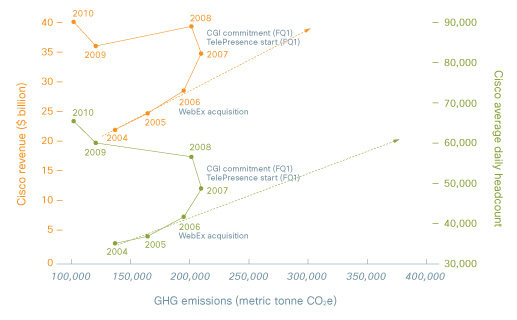Cisco's sustainability report offers proof points for green tech

If there is one company you would expect to have a lot to say about the potential green impact of collaboration and networking technology on corporate sustainability goals, it is Cisco.
So, I suppose I'm not surprised that so much space is given to this topic in the press materials for its new 2010 Corporate Social Responsibility (CSR) Report released this week. It is a classic case of a company eating its own dogfood. In this case, that dogfood comes in the form of the TelePresence videoconferencing technology and WebEx and MeetingPlace virtual meeting services.
In the report, Cisco discloses that its general-use TelePresence units are in action about 50 percent of the time, based on a 10-hour business day. As of the close of fiscal year 2010 last summer, the company had 334 Cisco TelePresence rooms of its own in 73 different cities around the world (not counting what customers or partners have installed). Cisco's use of WebEx and MeetingPlace as a means of averting physical business travel has helped double the company's use of these conferencing services in each of the past two years. In FY2010, Cisco employees attended 19.3 million millions of people hours (that is, one person attending for one hour). That is a hell of a lot of meetings.
I know that Cisco's appetite for WebEx is extraordinary because I occasionally help the company's worldwide channel partner programs divisions with messaging and am intimately familiar with WebEx. I wanted to disclose that in the context of this blog, although the messaging that I have worked on has nothing to do with Cisco's smart grid, green IT or corporate sustainability strategies.
The chart below, which I pulled from the 2010 CSR Report, attempts to illustrate the impact of collaboration technologies on offsetting Cisco carbon and greenhouse gas emissions.
I personally think that the green impact of videoconferencing and collaboration technologies is overstated and even Cisco admits it is difficult to make an exact comparison. Still, Cisco's greenhouse gas emissions goal calls for a 25 percent absolute reduction by 2012, based on a 2007 baseline, and the company says it continues to make progress toward that goal. Overall, it has reduced its air travel by 45 percent and cut Scope 1 and Scope 2 emissions by 12 percent on an absolute basis, according to the new report.
One piece of its report that had me raising my eyebrows surrounded the company's renewable energy purchases, which have declined over the past year.
During FY2010, Ciso sourced approximately 27 percent of its electricity from renewable sources, a strategy it uses as appropriate, depending on the region. That was actually less than it sourced in fiscal year 2009, though, when renewables contributed 37 percent. (The number of gigawatt hours purchased in FY2010 was 351 compared with 469 the previous year.) Still, Cisco IS currently the No. 12 company on the U.S. Environmental Protection Agency's Green Power Partner national 50 list.
Honestly, can't really argue with the fact that Cisco and other IT companies continue to do more than their fair share of working toward environmental progress. Of the top 10 companies on Newsweek's recent green business ranking, eight hail from the high-tech industry. Although Cisco isn't there yet, it does check in at No. 13.
